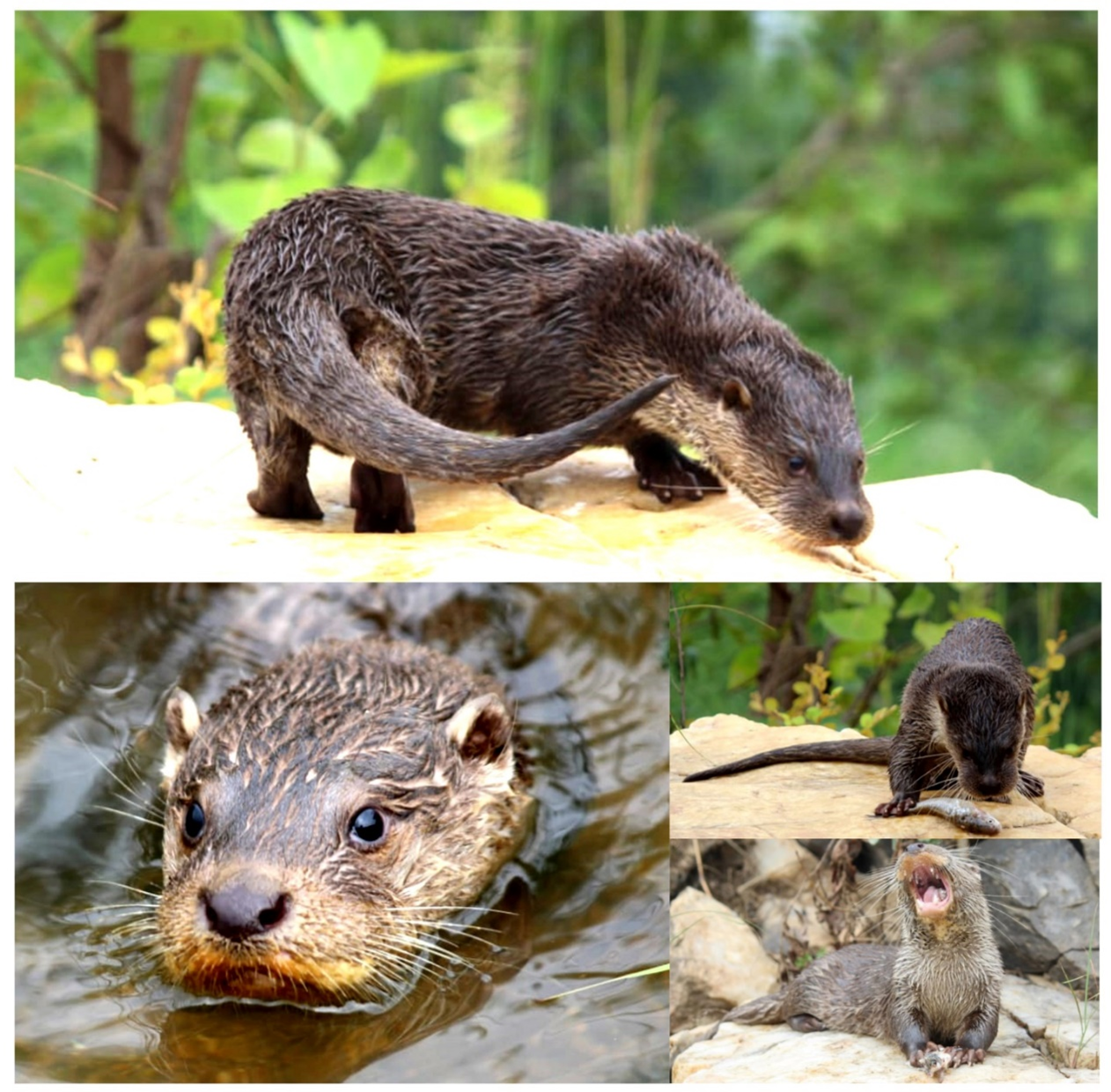IUCN/SSC Otter Specialist Group Bulletin

©IUCN/SCC Otter Specialist Group
Citation: Palei, N.C., Palei, H.S., Rath, s., Rath, B.P., and Mishra, A.K. (2022). Photographic Record of Eurasian Otter Lutra lutra (Linnaeus, 1758) in Odisha, India. IUCN Otter Spec. Group Bull. 39 (2): 102 - 109
Photographic Record of Eurasian Otter Lutra lutra (Linnaeus, 1758) in Odisha, India
Nimain Charan Palei1*, Himanshu Shekhar Palei1, Sabyasachi Rath2, Bhakta Padarbinda Rath3, and Arun Kumar Mishra4
1Office of the Principal Chief Conservator of Forests (Wildlife) & Chief Wildlife Warden, Odisha, India
2Aranya Foundation, Bhubaneswar, Odisha, India
3Office of the Range Officer, Ujalpur, Sundargarh Forest Division, Odisha, India
4Office of the Regional Chief Conservator of Forest, Rourkela Circle, Odisha, India
*Corresponding Author Email: wildpalei@gmail.com
Abstract: The Eurasian otter (Lutra lutra) is a rare and lesser-known top predator of the aquatic ecosystem in India. A Eurasian otter was photographed on 9 July 2021 in a village in the Sundargarh forest division in the state of Odisha during a biodiversity survey. This record is an important addition to the currently limited information available for species distribution in the state of Odisha as well as in India. Further study is warranted to assess the genetic and demographic resilience of the population.
Keywords: Lutra lutra, Eurasian otter, photographic evidence, Sundargarh Forest Division Odisha, central India
INTRODUCTION
The Eurasian otter (Lutra lutra) is one of the most widely distributed Palaearctic mammals with a geographical range from Ireland in Western Europe to the Kamchatka Peninsula in eastern Asia, from the Arctic region to north Africa and as far as south as Sumatra and Indonesia in Southeast Asia (Mason and Macdonald, 1986). The Eurasian otter is a semi-aquatic mammal, a top predator in the aquatic ecosystem, and plays a crucial role in the functioning of these systems (Mason and Macdonald, 1986). The Eurasian otter inhabits a wide variety of aquatic environments, including rivers, streams, lakes, swamp forests and coastal areas (Mason and Macdonald, 1986). This species is more vulnerable to loss and degradation of habitats, as currently, wetlands are amongst the most threatened and vanishing ecosystems worldwide (Davidson, 2014). Other threats are human persecution, persistent organic pollutants, and fish community alternations due to over-fishing (Roos et al., 2015; Buglione et al., 2020). Despite its broad distribution, the species is currently categorized as “Near Threatened” by the International Union for the Conservation of Nature (IUCN), owing to population decline in the last three generations or 23 years (Roos et al., 2015). The Eurasian otter is listed on Appendix I of CITES which indicates that the species is threatened with extinction and may be affected by trade (CITES, 2017).
Out of 13 extant species of otters found worldwide, India is home to three species of otter, namely Asian small-clawed otter (Aonyx cinerea), Smooth-coated otter (Lutrogale perspicillata) and Eurasian otter (Hussain, 1999). In India, Asian small-clawed otter is found from the Himalayan foothills of Himachal Pradesh to West Bengal, Northeast India, as well as in southern Indian hill ranges of Karnataka, Tamil Nadu and Kerala (Pocock, 1941; Hussain et al., 2011) and eastern India of Odisha (Mohapatra et al., 2014a). The Smooth-coated otter is distributed throughout India from the Himalayas southwards and has been reported from the north Indian states of Himachal Pradesh, Punjab, plains of Uttar Pradesh, Madhya Pradesh, Rajasthan, Bihar, in the central Indian plateau of Madhya Pradesh, Maharashtra, Goa, Andhra Pradesh, in the east and northeast in Odisha, West Bengal, Assam through Burma, in the south in Karnataka, Kerala and Tamil Nadu (Prater, 1971; Hussain, 1999). The Eurasian otter is distributed north of the Ganges river extending throughout the Himalayas, Northeast, in the eastern region along the Odisha coast, up to Madras, and then to south India (Hussain, 1999). Recently the Eurasian otter has been recorded from central India (Jena et al., 2016; Joshi et al., 2016; Talegaonkar et al., 2021), Western Ghats (Mudappa et al., 2018), and in the coastal region of Odisha, eastern India (Adhya and Dey, 2020). Unlike the other two species of otter in India, the Eurasian otter receives little scientific attention in India because of its rarity status (Hussain, 1999). It is considered an endangered species in India, features in Schedule-I of the Indian Wildlife (Protection) Act, 1972. Overall, lack of detailed information on its conservation status has designated it as one of the poorly known species in India.
Although Odisha has numerous hill streams, an extensive network of rivers and an array of marshy and mangrove habitats along the coast (Fig. 1), oft-used habitats of the otters, information on the occurrence and distribution of all three species in the state is poorly known. Although all three species of otters have been reported from Odisha (Debata and Palei, 2020), only a few records have been published on the species historically or recently. The earliest otter (Common otter or Eurasian otter, Lutra vulgaris) records date back to 130 years ago from Chilika Lake (Blanford, 1888-91). Annandale (1915) reported Smooth-coated otter (Lutra macrodus) when mammal collection was made from Satapara, Chilika Wetland by Zoological Survey of India. Mishra et al. (1996) revealed the occurrence of Smooth-coated otters all over the state, including mangrove swamps and coastal plains. From 1964 to 1999, eleven young specimens of both sexes of smooth-coated otters were received at Nandankanan Zoological Park from coastal areas of Odisha (Acharjyo, 1999). Mohapatra et al. (2014a) reported the occurrence of Asian small-clawed otters in several locations in Odisha. Adhya and Dey (2020), for a second time, reported the occurrence of Eurasian otter in Chilika Lake, Odisha coast. In a camera trap study, Palei et al. (2020) reported Smooth-coated otter's occurrence and activity pattern in Bhitarkanika National Park, Odisha. Here we report the photographic evidence of Eurasian otter from Sundargarh forest division, Odisha, India.

The Sudargarh forest division, western Odisha shares its boundaries with Chhatisgarh and Jharkhand state of India. It covers 3776 km2 and is dominated by tropical dry-deciduous, northern tropical dry-deciduous and northern dry-mixed deciduous forests (Champion and Seth, 1968). The mean minimum and maximum temperature varied from 6-20 °C in January and 35-45 °C in May. The mean annual rainfall is 1100-1500 mm during the monsoon between June and September. The terrain is undulating and hilly and the altitude ranges from 152 m to 903 m. The forest division supports the population of several large threatened mammals, such as Asian elephant (Elephas maximus), tiger (Panthera tigris), leopard (Panthera pardus), sloth bear (Melursus urisinus) and Indian grey wolf (Canis lupus) (Palei et al., 2018a, 2019b).
OBSERVATIONS
During a survey of aquatic fauna in Sundargarh forest division, Odisha, India, we observed a semi-captive otter in the village Dhelsara, near river Ichha (22.06594º, 83.892243º) (Fig. 1, 2). We were able to get further details of the captured otter after enquiring the villager who has captive the otter. The villager has rescued the otter cub from the local dogs near the Ichha Nallah in December 2020. The otter group might have been left the cub and escaped away from the local dogs. After being rescued, the otter cub was fed cow’s milk every day with a nipple bottle for two months. After that, the owner started feeding rice and fish, including dry fish. The 8-month year male cub was freed from any chain and control and moved freely in the house and backyards. The owner took the otter to the river every day 2-3 times. The otter swam well in the river and started searching for own food also depends on the food offered by the villager. The owner tried to release the otter into the wild several times, but the otter returned home every time. We identified as the otter was sub-adult male and took the following measurements: the weight was 2.8 kg, the head to the base of tail length was 58 cm, the tail length was 37 cm, the chest girth was 49 cm, and the height was 18 cm. The pelage was dark brown on the dorsal side and lighter on the underside. The otter had long, prominent claws and semi-webbed feet. The species was identified as a Eurasian otter based on the pronounced muzzle, zig-zag pattern, or “W” shaped naked rhinarium and cone-shaped tail (Fig. 2).
During the survey, we encountered several spraints and footprints of otters in the river stretches. Informal discussion with villagers revealed that they confirmed the presence of the otter group in this area. However, from the otter sign, we were unable to confirm the presence of other species of otter such as Asian small-clawed otter which is reported in different parts of the state (Mohapatra et al. 2014a). Further detailed camera trap study is required to ascertain the presence of other species of otter in this area. The Ichha River is a high gradient stream with a sandy bottom and a channel width of approximately 50 meters (Fig. 3, 4). The banks of the river were sandy with sporadic vegetation. The river leads to Ib River, which is one of the major tributaries of the Mahanadi River. The study site is the human habitation area, and both sides of the river were dominated by agricultural land. We observed rampant fishing, cattle grazing and sand mining by locals in this area.
CONCLUSION
The photographic evidence of the Eurasian otter obtained through this study further confirms the presence of this species in Odisha. Our record of the Eurasian otter from Sundargarh forest division is about 300 km from the locations of the previous report from Odisha, showing an extension from its previously known geographic location of the state. Also, it extends the known geographical range of the species in the central Indian landscape. Previous studies have likely overlooked the presence of the Eurasian otter in this area because of its elusive behaviour and lack of species-level identification skills. However, recently biologists have expanded the known distribution ranges of several species in Odisha (Mohapatra et al., 2014a; Mohapatra and Palei, 2014b; Debata et al., 2015; Palei et al., 2018a; Palei and Debata, 2019a; Palei et al., 2019b,c; Palei et al., 2021). Therefore, further targeted and intensive studies of the Eurasian otter in the possible localities are essential to better understand this rare species and formulate appropriate conservation plans for its long-term survival.
Acknowledgements: We are thankful to the Principal Chief Conservator of Forest (Wildlife) and Chief Wildlife Wardens, Odisha for support. We are also thankful to the forest departmentof Sundargarh forest division for their unfailing extended help during the fieldwork. We thank the editor and anonymous reviewers for valuable discussions and comments that significantly improved the quality of manuscript.
REFERENCES
Acharjyo, L.N. (1999). Status of Mustelids, Viverrids and Herpestidsof Orissa. In: Envis Bulletin on Wildlife and Protected Areas. Hussain, S.A. (Eds) WII, Dehradun, 2: 62–64.
Adhya, T.,Dey, P. (2020). First record of Eurasian otter (Lutra lutra) from Chilika lagoon: a Ramsar site situated on the East coast of India. OTTER the Journal of the International Otter Survival Fund, 6: 49-55.
Annandale, N. (1915). Fauna of the Chilka Lake: Mammals, Reptiles and Batrachians. Memoirs of Indian Museum 5(2): 165–174.
Blanford, W.T. (1888–1891). The Fauna of British India, Including Ceylon and Burma. Mammalia. Part I & II. Taylor and Francis, RedLion Court Fleet Street, London, p. 617.
Buglione, M., Petrelli, S., Troiano, C., Notomista, T., Rivieccio, E., Fulgione, D. (2020). The diet of otters (Lutra lutra) on the Agri river system, one of the most important presence sites in Italy: a molecular approach. PeerJ 8: e9606. DOI: https://doi.org/10.7717/peerj.9606
Champion, H.G., Seth, S.K. (1968). A Revised Study of the Forest Types of India. Government of India. New Delhi, India, p. 404.
Davidson, N.C. (2014). How Much Wetlands has the WorldLost? Long-term and Recent Trends in Global Wetland Area.Marine and Freshwater Research, 65(10): 934-941.
CITES, (2017). Convention on International Trade in Endangered Species of Wild Fauna and Flora. Appendices I, II and III. http://checklist.cites.org .
Debata, S., Palei, H.S. (2020). An updated checklist of mammals of Odisha, India. Journal of Threatened Taxa, 12(10): 16219-16229.
Debata, S., Palei, H.S., Mohapatra, P.P., Palita, S.K. (2015). Additionalrecords of Cantor’s Leaf-nosed Bat Hipposideros galeritusCantor,1846 (Mammalia: Chiroptera: Hipposideridae) in eastern India: Odisha. Journal of Threatened Taxa, 7(8): 7477-7479.
Hussain, S.A. (1999). Status of otter conservation in India. Environmental Information System Bulletin: Wildlife and Protected Areas, Mustelids, Viverrids and Herpestids of India 2: 92-97.
Hussain, S.A., Gupta, S.K. and de Silva, P.K. (2011). Biology and Ecology of Asian Small-Clawed Otter Aonyx cinereus (Illiger, 1815): A Review . IUCN Otter Spec. Group Bull., 28(2): 63-75. https://www.iucnosgbull.org/Volume28/Hussain_et_al_2011.html
Jena, J., Bhargava, D., Borah, J., Dey, S. (2016). Notes on the occurrence of the Eurasian otter (Lutra lutra l.) in the forest of Balaghat, Madhya Pradesh, India. IUCN SCC Otter Spec. Group Bull., 33: 59-63. https://www.iucnosgbull.org/Volume33/Jena_et_al_2016.html
Joshi, A.S, Tumsare, V.M, Nagar, A.K, Mishra, A.K, Pariwakam, M.P. (2016). Photographic records of Eurasian otter Lutra lutra from the Central Indian Landscape. IUCN Otter Spec. Group Bull., 33(2): 73-78. https://www.iucnosgbull.org/Volume33/Joshi_et_al_2016.html
Mason, C.F., Macdonald, S.M. (1986). Otters: Ecology and Conservation. Cambridge University Press, Cambridge, UK.
Mishra, C.G., Patnaik, S.K., Sinha, S.K., Kar, S.K., Kar, C.S., Singh, L.A.K. (1996). Wildlife Wealth of Orissa. Orissa Government Press, Cuttack, p. 180.
Mohapatra, P.M., Palei, H.S., Hussain, S.A. (2014a). Occurrence of Asian small-clawed otter Aonyx cinereusin Eastern India. Current Science, 107: 367-370.
Mohapatra, P.P., Palei, H.S. (2014b). Further record of Large Indian Civet Viverra zibetha Linnaeus, 1758 from Odisha. Journal of the Bombay Natural History Society, 111(2): 125.
Mudappa, D., Prakash, N., Pawar, P., Srinivasan, K., Ram, M.S., Kittur, S., Umapathy, G. (2018). First record of Eurasian Otter Lutra lutra in the Anamalai Hills, Southern Western Ghats, India. IUCN Otter Spec. Group Bull. 35(1): 47-56. https://www.iucnosgbull.org/Volume35/Mudappa_et_al_2018.html
Palei, H.S., Das, U.P., Debata, S. (2018a). The vulnerable fishing cat Prionailurus viverrinus in Odisha, eastern India: status and conservation implications. Zoology and Ecology, 28(2): 69-74.
Palei, H.S., Debata, S. (2019a). On the occurrence of Rusty-spotted Cat Prionailurus rubiginosus (I. Geoffroy Saint-Hilaire, 1831) (Mammalia: Carnivora: Felidae) in Odisha, Eastern India. Proc. Zool. Soc., 72: 102-105.
Palei, H.S., Palei, N.C., Rath, B.P., Mishra, A.K. (2019b). Records of the globally threatened rusty-spotted cat in Odisha, India. Nature Conservation Research, 4(3): 112-116.
Palei, N.C., Rath, B.P., Behura, S.,Palei, H.S. (2021). New elevation record of fishing cat occurrence in Odisha, eastern India. CATnews, 72: 16-17.
Palei, N.C., Rath, B.P., Palei, H.S., Acharya, B.P. (2020). Population Status and Activity Pattern of Smooth-Coated Otter (Lutrogale perspicillata) in Bhitarkanika National Park, Odisha, Eastern India. IUCN Otter Spec. Group Bull., 37(4): 205-211. https://www.iucnosgbull.org/Volume37/Palei_et_al_2020.html
Palei, N.C., Rath, B.P., Palei, H.S.,Mishra, A.K. (2018b). Occurrence of melanistic leopard in Odisha, eastern India. CAT news, 68: 7-8.
Palei, N.C., Rath, B.P., Palei, H.S.,Mishra, A.K. (2019c). Photographic evidences of Indian grey wolf (Canis lupus pallipes) in Sundargarh forest division, Odisha, India. e-planet, 17(2): 152-156.
Pocock, R.I. (1941). The Fauna of British India including Ceylon and Burma. Vol. II. Taylor and Francis, London. p. 503.
Prater, S.H. (1971). The Book of Indian Animals. 3rd edition. B.N.H.S., Bombay, India.
Roos, A., Loy, A., de Silva, P., Hajkova, P.,Zemanová, B. (2015). Lutra lutra. The IUCN Red List of Threatened Species 2015: e.T12419A21935287. https://dx.doi.org/10.2305/IUCN.UK.2015-2.RLTS.T12419A21935287.en. Downloaded on 22 July 2021.
Talegaonkar, R., Salaria, S., Bhargava, D., Jena, J., Rahul, S.K., Dhamorikar, A., Chanchani, P. (2021). Habitat use by the Eurasian Otter (Lutra lutra Linnaeus 1758) in a Non-Protected Area of Madhya Pradesh, India. IUCN Otter Spec. Group Bull. 38(4): 217-227. https://www.iucnosgbull.org/Volume38/Talegaonkar_et_al_2021.html
Résumé: Enregistrement Photographique de la Loutre Eurasienne Lutra lutra (Linnaeus, 1758) dans l’Odisha en Inde
La loutre eurasienne (Lutra lutra) est un top prédateur rare et peu connu de l’écosystème aquatique en Inde. Une loutre eurasienne a été photographiée le 9 juillet 2021 dans un village de la division forestière de Sundargarh dans l’État d’Odisha lors d’une enquête sur la biodiversité. Cet enregistrement est une information supplémentaire importante pour les données actuellement disponibles sur la répartition des espèces dans l’État d’Odisha ainsi qu’en Inde. Une étude plus approfondie se justifie pour évaluer la résilience génétique et démographique de la population.
Revenez au dessus
Resumen: Registro Fotográfico de la Nutria Eurasiática Lutra lutra (Linnaeus, 1758) en Odisha, India
La Nutria Eurasiática (Lutra lutra) es un predador-tope raro y poco conocido de los ecosistemas acuáticos de India. El 9 de Julio de 2021 fue fotografiada una nutria Eurasiática en un poblado en la división forestal Sundargarh, en el estado de Odisha, durante un relevamiento de biodiversidad. Este registro es una adición importante a la información actualmente limitada sobre la distribución de la especie en el estado de Odisha -así como en India. Se hacen necesarios estudios ulteriores para evaluar la resiliencia genética y demográfica de la población.
Vuelva a la tapa
ସାରାଂଶ: ଇଉରାସିଆନ୍ ଫୋଟ୍ରୋଗ୍ରାଫିକ୍ ରେକର୍ଡ | Lutra lutra (Linnaeus 1758) ଭଡା, ଭାରତ
ୟୁରାସିଆନ୍ ଓଧ (ଲୁଟ୍ରା ଲୁଟ୍ରା) ହେଉଛି ଭାରତର ଜଳଜୀବ ପରିସଂସ୍ଥାର ଏକ ବିରଳ ତଥା ବହୁତ କମ୍ ଜଣାଶୁଣା ଶୀର୍ଷ ଶିକାରୀ। ଓଡ଼ିଶା ରାଜ୍ୟ ଅନ୍ତର୍ଗତ ସୁନ୍ଦରଗଡ ବନଖଣ୍ଡର ଜୈବବିବିଧତା ସର୍ବେକ୍ଷଣ ସମୟରେ ଏକ ଗ୍ରାମରେ ୯ ଜୁଲାଇ ୨୦୨୧ ରେ ଏକ ଇଉରାସିଆନ୍ ଓଧର ଫଟୋ ଉତ୍ତୋଳନ କରାଯାଇଥିଲା। ସାମ୍ପ୍ରତିକ ଓଡ଼ିଶା ତଥା ଭାରତରେ ଏହି ପ୍ରଜାତିର ଅବସ୍ଥିତି ଏବଂ ବିସ୍ତାରଣ ସମ୍ପର୍କରେ ସୀମିତ ସୂଚନା ଉପଲବ୍ଧ ଥିବା ସମୟରେ ଏହି ରେକର୍ଡଟି ଏଥିଲାଗି ଏକ ଗୁରୁତ୍ୱପୂର୍ଣ୍ଣ ଯୋଗଦାନ କରୁଅଛି। ଏହି ପ୍ରଜାତିର ଆନୁବଂଶିକ (ଜେନେଟିକ୍)ଅନୁଶୀଳନଏବଂଜନସଂଖ୍ୟାସ୍ଥିରତାକୁଆକଳନକରିବାଲାଗିପରବର୍ତ୍ତୀଅଧ୍ୟୟନଜରୁରୀଅଟେ।







